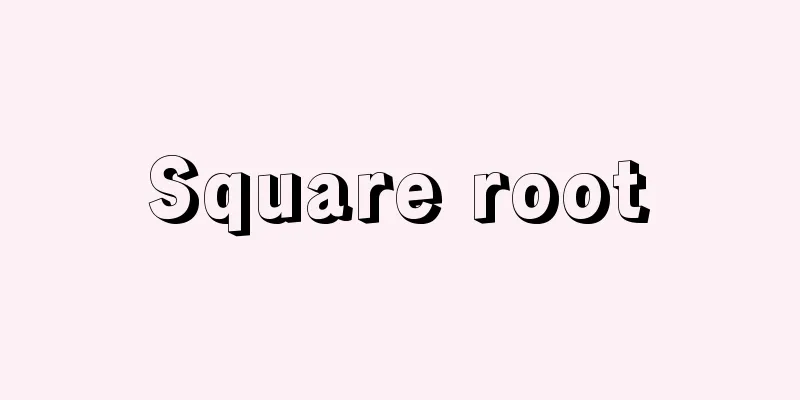Square root

|
When a number a is given, the number x that, when squared, gives a , in other words, the number x such that x 2 = a, is called the square root of a . When a is a positive number, there is one positive and one negative square root of a , and their absolute values are equal. The positive one is written as . is read as root a . The negative one is represented as -. Therefore, in this case, the square root of a can be summarized as ±. For example, the square root of 2 is and -, which can be summarized as ±. In this case, the symbol is called a radical sign (or square root sign). The square root of 0 is just 0. Also, the square root of a negative number is not a real number, but an imaginary number. For example, the square root of -2 is i and -i ( i is the imaginary unit). Let's consider the square root of a positive integer. When a is a square number, that is, a number that can be written as the square of a positive integer n , n 2 , then a is equal to n (for example, a = 2). However, when a is not a square number, a is never a rational number, but an irrational number. In other words, it can never be expressed as a finite decimal or fraction, but rather as a non-repeating infinite decimal (for example, a = 1.41421356...). If the length of one side of a square is 1, then the length of the diagonal can be expressed as, but the ancient Greeks already knew that a was an irrational number. This can be seen in Euclid's Elements. When we are considering the square root of a positive number, the radical symbol always represents a positive number. This is the convention for the radical symbol. So, when a > 0, it is = a , but when a < 0, a 2 > 0, so it is = - a . Sometimes the square root is contained within the square root sign. For example, [Tatsuro Miwa] ©Shogakukan "> How to find and remember square roots Source: Shogakukan Encyclopedia Nipponica About Encyclopedia Nipponica Information | Legend |
|
数aが与えられたとき、二乗(平方)してaとなる数、つまり、x2=aとなる数xをaの平方根という。aが正の数のときは、aの平方根は正の数、負の数それぞれ一つずつあり、その絶対値は等しい。そして、正のほうを、と書く。は、ルートaと読む。負のほうは、-で表される。したがって、このとき、aの平方根は、±とまとめられることになる。たとえば、2の平方根は、と-で、±とまとめられる。この場合、記号を、根号(または平方根号)という。0の平方根は0だけである。また、負の数の平方根は、実数でなく、虚数である。たとえば-2の平方根は、iと-iである(iは虚数単位で、のこと)。 正の整数の平方根について考える。aが平方数、つまり、ある正の整数nの平方の形n2と書かれる数であるときは、はnに等しい(たとえば =2)。しかし、aが平方数でないとき、は有理数になることはけっしてなく、無理数になる。つまり、有限小数や分数で表されることはなく、循環しない無限小数になる(たとえば=1.41421356……)。正方形の一辺の長さを1とすれば、対角線の長さはと表されるが、が無理数であることを古代ギリシア人はすでに知っていた。それは、ユークリッドの『原論』にみられる。 正の数の平方根について考えているとき、根号はつねに正の数を表す。これが根号の規約である。すると、a>0のとき=aであるが、a<0のときa2>0であって、=-aとなる。 平方根号の中に平方根が含まれることがある。たとえば、 [三輪辰郎] ©Shogakukan"> 平方根の求め方と覚え方 出典 小学館 日本大百科全書(ニッポニカ)日本大百科全書(ニッポニカ)について 情報 | 凡例 |
<<: Mi-fa shan-shui (English: Mi-fa shan-shui)
Recommend
Hair oil - Kami-Abura
Oil used for styling hair, giving it shine and nu...
Arctic car - Arukuchikago
...The following March, Skate surfaced at the Pol...
Jean Valjean
The protagonist of the novel Les Miserables (1862)...
I Ching - Ekikyo
It is an ancient Chinese divination book, and one...
Nagashima Aiseien
Japan's first national leprosy sanatorium. Com...
St. George's Channel - Saint George's Channel
A strait between southeastern Ireland and southwes...
Arum italicum (English spelling)
...The spadix, surrounded by a spadix, has female...
Pasquale Paoli
1725‐1807 Corsican patriot and politician. In 1739...
Coromandel Coast - Coromandel Coast
The coastline on the eastern coast of the Indian ...
North Anatolian Fault
...Recent earthquakes include the 1978 Tabas eart...
Hugo Stinnes
A major German capitalist. He took over his famil...
Ogori [city] - Ogori
A city in the central south of Fukuoka Prefecture....
Deposit system - Azukarikinseido
...The Japanese-Portuguese Dictionary, which incl...
Atahui - Atahui
...A faction of the Yuan army, consisting mainly ...
Koriyanagi - Koriyanagi
A deciduous shrub of the Salicaceae family (APG c...









